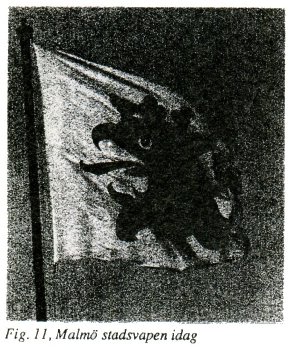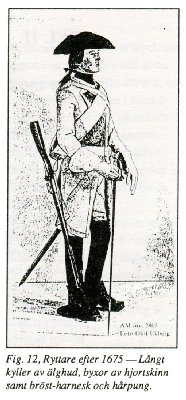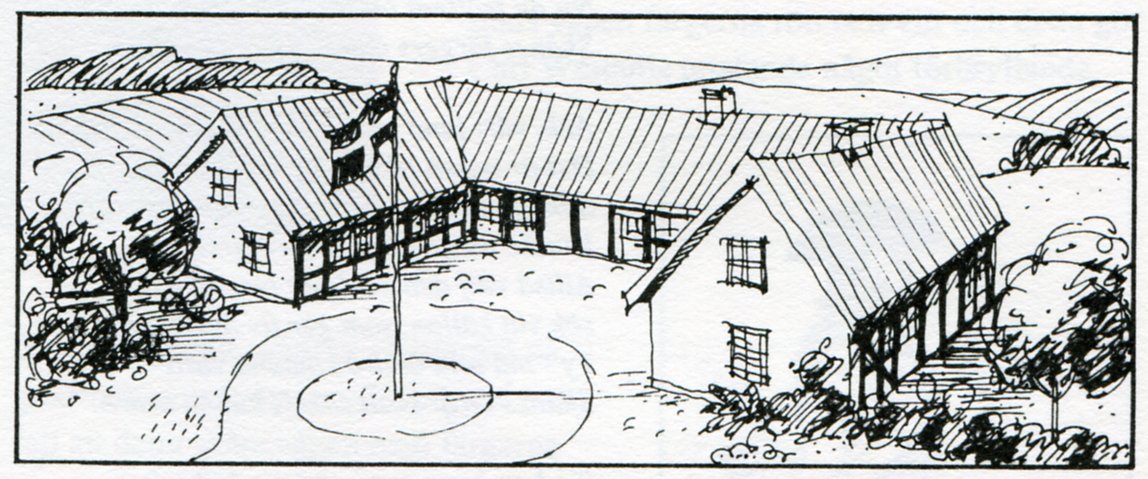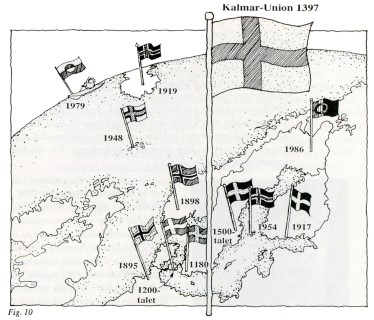
THE FLAG OF SCANIA
The complete text
"The Red and Yellow Cross Flag, History and Stories Told"
Sven-Olle R Olsson, Ph.D. Malmö
Publisher and Copyright: Stiftelsen Skånsk Framtid. 1993.
Due to the size of this publication, it has been divided into three parts:
Part 1: Foreword - Historical beginnings.
Part 2: History of the modern Scanian Flag.
Part 3: Appendices.
Part 2
The History of the Modern Scanian Flag
Who is the re-creator or creator of the "Scanian flag" - is it Martin Weibull or his brother Mathias? It is often said that Martin Weibull created the flag in the 1870's. Martin Weibull and his sons, Lauritz, Carl-Gustaf and Curt, were all legendary researchers of history at Lund, and they created a school of thought in historical research with respect to the critical evaluation of sources. All except Carl-Gustaf became professors of history and all were involved in Scanian history. Without them, we Scanians would have had much of our history still to be written. Martin and Mathias, the latter a professor at Alnarp, had their origins in the Danish village of Vejbol. Their origins may perhaps explain their interest in Scania and Denmark. With respect to the Scanian flag, it is probable that both were behind it. Martin Weibull also created the concept of Skåneland at the end of the 1800's. Previously, he and others had used the concept of Skåne in a wide sense as including the Scanian provinces of Skåne, Blekinge, Halland and Bornholm. This fully corresponds to the Latin concept of Scania as the Scanian provinces, i.e. Skåneland.
Curt Weibull, Martin's son, writes in the pamphlet Ale, 1988: "First of all, I want to clear my father, Professor Martin Weibull, of being the originator of the Scanian flag. He died on April 17, 1902, at a time when the idea of a Scanian flag had not, as far as we know, yet arisen or even been suggested. The idea of a Scanian flag originated with my uncle Mathias Weibull and all credit must go to him." Curt Weibull continues by telling about Mathias' property, Sofieholm at Fosie, and that he came home one day with a Scanian flag in 1902. Whether the flag was ever raised, he doesn't know.
The flag was later raised in connection with a fire that ravaged the home in 1908. As for the colours, Curt Weibull says: "I have, however, heard from one of my sisters, that the colours were based on the colours of the coat of arms that Erik of Pomerania gave to Malmö" (in 1437). A picture of this coat of arms was included in a book published by Lauritz Weibull in 1901, "The Annals of Malmö City" (Malmö stads urkundsbok). As is well known, the coat of arms of Malmö City has the colours of red and white, so this statement of his is somewhat perplexing.


The Scanian griffin
The Scanian griffin, however, is red on a gold background and in that case it is more likely that this Scanian coat of arms with the colours of red and gold is the reason for the choice of colours.
The Scanian griffin was created for the funeral of Charles X Gustav in 1660, as a modification of the coat of arms of the City of Malmö. This colour choice for the Scanian griffin, as well as the uniform colours in yellow and red of the 1675 Dragoons of Scania and province of Bohus, could perhaps be viewed as proof that even the Swedish conqueror had noticed the old colours of Scania. Thus, it is quite clear that yellow and red can be regarded as Scania's colours, and it is obvious that Martin and Mathias Weibull knew this. An extremely peculiar explanation for the choice of colours, and one that we should perhaps not even take seriously, is the one in a letter to the editor from 1967 written by the editor of the Byahornet, Moje Biarner. He says, that Martin always brought a Danish flag on his travels and that it gradually turned red and yellow instead of red and white, and that it from then on was viewed as a Scanian flag.
In connection with the discussion about the Scanian griffin, we should perhaps note that also Blekinge and Halland have their own provincial coat of arms and Bornholm has its own flag, red with a green cross (Andersson, 1992). These symbols can, of course, serve as provincial flags, but there is no other common symbol for Scania as a whole including Bornholm than the red and yellow cross flag.
Before leaving the matter of the Scanian griffin, it may be of interest to consider David Assarsson's view of the Scanian flag in his work "The Scanian Problem" from 1923. He has given it poetic expression in a poem entitled "Colours of Scania":
Colours of Scania
Brother, you once an expression heard,
that the strings of your heart strangely stirred.
Scania's colours? Mysterious sound the words.
You yourself you did not understand what they meant,
and when you asked others to explain,
they had no answer to your question.
Now you have tired of searching in vain,
the meaning of Scania's colours you must find out.
Oh, our country carries not only golden harvests.
It is also rich in golden memories.
Search among them! 'though none now them honour,
perhaps an answer they give for questioning minds.
So choose the simplest method,
seek the source that gives life to the river.
For - even though all others may be silent -
Scania's Griffin shall know the answer.
See he shines, warmed by healthy forces,
the bird that was nourished by Scania's soil.
Health his feathered chest with colours has moulded.
High among the dance of suns and swarming stars.
Red he rises against a yellow sky,
coloured by the light of morning glow.
Thus he answers each one who queries:
Red and yellow glows from Scania's weapon.
Red is the reflection of the Danish flag,
red as poppy glory in the golden rye.
Red is the crusader flag in the midst of battle,
the rose of our people's song in the gardens of herbs,
holy as the altar fire that Eskil tends,
the sun of fame from Tyge Brahe's sky.
Red is darkened light from burning cities,
blood that dresses Scania's soil in purple robes.
Gold is the cross's stem on Sweden's flag,
golden hope on our future's path.
Gold scatters March sun from heaven's crest
over coltsfoot blooms along the path.
Yellow stands the willow by the road. Golden rain falls
richly on leaves of darkest green behind a garden's fence.
And when autumn our summer's gold has harvested,
already our forests on Scania's plains are autumn coloured.
Shine then forth from sombre northern mountain borders,
Scania in its future colours.
A thousand bursts of joy among summer's delights,
spread Scanian gold on Kullen's heights.
Across Lunda plain and Ringsjö waters
shine star light in this night of June
and from Hallandsås to Ystad region, sound
Scania's song in steadfast rhythms.
David Assarsson

We should emphasise that Assarsson connects the red and yellow colour to the flags of Denmark and Sweden, respectively. This is probably not the origin of the colours, but it is a remarkable and positive coincidence that Scania's colours can be viewed as a combination of Swedish and Danish colours.
The use of the Flag during the 20th Centruy - "Bonnaflaggan"
It is also said that it was popular to "fly the Scanian" up to the 1940's and this custom was reintroduced in the 1960's. There are many eyewitness accounts that confirm this. An elderly gentleman said that when he started out as a hardware store assistant in Trelleborg in 1935, he sold many Scanian flags to the big estate farmers. It was very common that the big estate farmers on the Southern Plain (Söderslätt) flew the Scanian flag. The flag is therefore known in popular language as the "peasant flag" (bonnaflagga).
A 70-year old woman recently told us that she still has her grandmother's mother's Scanian flag, which she received when she was 6 years old, i.e. around 1928. It is a bit worn and is now stored at the bottom of the chest. It is only taken out on special occasions, when she uses it as a decoration. The age of the flag is not known, but it should be from the turn of the century. Eric Lundblad Inc., a Malmö company that sold goods such as coffee, used the Scanian flag as its logo in the 1950's, according to Bengt Biarner. The Executive Director of the company, Yan Westrup put the flag on his fancy Bentley. Bengt Biarner also tells us that he saw the Scanian flag for the first time at the Sjöberg flag factory in Malmö in 1946 and that it was used in Tottarp in the 1950's.
A newspaper article from 1968 tells the story of how Hugo Mattson at the Inn of Brösarp had used the Scanian flag for 11 years, i.e. since 1957. He says that it was actually a professor of botany from Uppsala who told him that since there happens to be a Scanian flag, they might as well use that instead of all manner of foreign flags. Mattsson ordered a Scanian flag from the flag factory Kronan in Helsingborg, which hadn't produced many Scanian flags before. In 1967, however, they produced 25,000 Scanian flags, which sounds a bit excessive. Hugo Mattsson continues: "But we feel that it is nice to have this provincial symbol and nowadays we are far from alone to fly the Scanian flag, not as we were in the beginning".
In 1965, on a visit to Lund, architect Peter Broberg encountered the flag. It was hanging from a balcony in the old city. The owner of the flag was Gunnar Gorton, Chief Physician, who told him that the flag was used a lot in his home area of the District of Frosta up to the second world war. Bengt Kihlberg confirms this, since he saw his first Scanian flag at Sätofta around 1933 to 1936. Gorton thought that he would be the last person to use it.
"The Scanian Friends of the Flag"
This flag discovery caused a group of Scanians, among them KarlErik Weggerup, Sten Sjöstrand, and Peter Broberg, to begin dispersing information about the flag. Within a couple of years, one could see the flag both on flagpoles and on cars around Scania. A major breakthrough came about through Sigge Hinderoth, who at the rest stop Bialitt started an annual celebration of the flag on The Day of the Scanian Flag, on the third Sunday of July. At the same time, the Association of the Friends of the Scanian Flag was formed. On this day, a Scanian of the year has been elected since 1967, except in 1987, when the Skåne Party (Skånepartiet) almost had succeeded in tainting the Scanian flag politically. However, strong popular indignation forced Carl P. Herslow to create his own flag for the Scania Party, and this left the Scanian cross flag in peace. It must never become a political symbol. Instead, it is a gathering symbol for the culture, history and people of Scania.
"Säpo and treason?"
In connection with the celebration of the first Scanian Flag Day on July 16, 1967, at Bialitt between Marieholm and Röstånga, a lot was written in the newspapers. Most newspapers were surprised and wrote about Scania's National Holiday, Scanian Revolution, and national liberation movements. The story goes that the King Gustav II Adolf, Prince Bertil, Prime Minister Tage Erlander, Torsten Nilsson, Minister of Foreign Affairs, and SÄPO (the Swedish Secret Police) were informed prior to the ceebration at Bialitt.
Somebody even tried to accuse the organisers of treason: I feel forced to report the incident to the authorities unless this is stopped. It is pure treason to arrange a Scanian flag day. This is an insult to both the Swedish and the Danish flag. If it is not sufficient to inform the police in Malmö, I will carry this further! (Arbetet, July 16, 1967).
Newspaper reacations
In sharp contrast to this kind of writing, were the reports the following day. SDS writes: The Day of the Scanian Flag at Bialitt passed just like the peaceful coffee party it was intended to be. No Scanian nationalists sneaked around fiddling with explosives and bullets. Tough police officers prepared to tear down illegal Scanian symbols were also conspicuously absent. The entire event was just a regular outing where people drank coffee, ate buns, listened to a Scanian ballroom band, distributed Scanian flags, and elected a Scanian of the Year.
It was Father Gunnar from Osby and Kristianstad who became the first Scanian of the Year, following a tough battle against "Steel Granpa" Gunnar Håkansson. The newspaper Skånska Dagbladet wrote that it was a PR event? Lars Holmqvist in the evening paper Aftonbladet was quoted as follows: "Is Scania developing into a Greenborough (a fictional town, characterised mainly by the stupidity of its inhabitants)? A pure money making proposition that makes us Scanians look ridiculous".
Columnist Cello suggested in the evening paper Expressen that Mårtensafton (Nov. 11 Scanian celebration) should have been chosen for the day instead of July 16. Restaurant owner Åke Sellert of Råå Inn and the actor Nils Poppe at Fredriksdal Theatre were among the pioneers who accepted the Scanian flag.
The demand for Scanian flags became too great for flag manufacturers to keep up with. They were sold out as fast as they could make them. Among letters to editors were these: "Un-Swedish! Ugly. Scania's death. Raise high the Scanian flag! Scanian flag day, just an artificial PR event".
As late as 1972, a distraught letter writer in Helsingborg's Dagblad wrote: Prohibit the Scanian Flag Day and he felt that it was a demonstration against the Swedish nation to fly the Scanian flag. - This cannot be understood as anything but an insult to the Swedish nation, which has sacrificed its blood, sweat and tears to acquire Scania.

In spite to the very calm and peaceful arrangements at Bialitt, it is very obvious that journalists tried to whip up regional hate feelings towards Sweden, and that the flag was a protest against everything Swedish: Now all Swedes see red. In many places in Scania, the red flag with a yellow cross is raised in protest against the common Swedish national symbol. It is not just a joke. In the Göinge region, there are historical reasons not to like Swedes. In the 1600's, entire villages were burnt and exterminated by good Swedes. If there was sabotage against a Swede, one out of every ten men was executed in the guilty parish. (See 1970).
Fortunately, some newspapers had understood the message of the Scanian flag, e.g. the Danish newspaper, Berlinske Tidende, which on July 8, 1968, wrote: - The red background reflects Scania's Danish origins, and the yellow cross reflects the Swedish era. The flag is meant to encourage Scanians to assume their place as a people bridging the gap between Scandinavians, and at the same time to strengthen Scania's uniqueness and acknowledge its history.
Ove Torny summarises fairly well the varying opinions of those days with regard to the Scanian flag in the newspaper NST of Wednesday July 22, 1970: People's perception of the Scanian flag vary quite considerably. For Swedes with origin north of the Scanian border it is primarily ridiculous, others rate it as irritating with respect to the purported plans of Scanians to reunite with Denmark, meaning liberation from Sweden with a canal dug along the border to Småland. Some see in the Scanian flag a symbol for re-unification and the common cultural heritage that we share with our brothers across the Sound. Others view it as a symbol of increasing future Nordic cooperation - the Swedish yellow and the Danish red colour. Others again want to give the Scanian flag a regional characteristic. Most feel perhaps that it is a fun and beautiful decoration for the car or on a flag-pole and that it is more beautiful than either the Swedish or Danish flag.
This entire series of reactions, some quite hysterical, show that Sweden found it difficult to accept cultural diversity. In other countries in Europe, there are a great many flags, local, regional, historical, cultural, and this does not cause any excitement.
Regions in Sweden
Currently, things have calmed down a bit in Sweden, since we now see little excitement created by other regional flags, such as those of Öland, Gotland, Småland, Östergötland, Norrland, or Jämtland (Andersson, 1992). Is this difference in reaction to the Scanian flag due to the fact that it was the first one, or is it due to a particularly strong Swedish reaction against Scania, since this is perhaps a particularly sensitive subject?
The Flag on Apollo II
A festive feature of the flag debate occurred in 1969. When Apollo II was to be launched on the Scanian Flag Day from the American space centre in Houston in 1969, Friends of the Scanian Flag took an initiative that attracted attention. A Scanian flag was sent to the space headquarters in Houston on July 1 with a request to place it on the moon beside the Stars and Stripes. The justification for this was that Scanian men had made substantial and decisive contributions when it came to the conquest of space.
Primarily, Tycho Brahe, born at Knutstorp, had created the basis for all future developments in astronomy through his astronomical observations and his remarkable creation of instruments. His work was continued and completed by Kepler and Newton. Secondly, there was Charles Lindberg, the son of an emigrant from Scania, who was the first to fly across the Atlantic, a first class feat. And thirdly, Aldrin, one of the three on board the spacecraft, was also the descendant of emigrants from Scania. This request created much and well-deserved media attention. It was also based on a combination of educational information and humor that is typically Scanian.
New activities
In recent years, Peter Broberg, a member of the Scanian Academy, has involved himself in the flag debate, for example in the Annals of the Scanian Academy (see e.g. 1988) and in the press. He is one of the founders of the Foundation and the Association for Scania's Future. Peter Broberg has always worked to protect diversity with respect to cultural identity and democracy. One of the results was this contribution to the debate: The large society from 1973, featuring a four-colour picture, where he suggests regional flags for several Nordic regions. Some of these flags, for example the flag suggested for Götaland, the reverse colour flag, have begun to gain acceptance and use.
In the same manner, Per Andersson of Örebro (Andersson, 1992) has gathered everything known about flags in the Nordic countries, and he describes 35 different flags for nations, cultural regions and provinces. Overall, it is possible to create many more heraldically correct cross flags employing the colours of gold and silver, as well as the shades of blue, red, green and black. In connection with our entry into the European community, we must be very tolerant towards regional strivings for identity, and accept the diversity of flags in the Nordic countries.
A very commendable effort to profile The Scanian culture and identity ("Det skånska") was made by Charlotte Weibull throughout many years of working in the cultural pedagogical field involving the culture and symbols of provinces.
The Scanian Flag today
It is very encouraging that the Scanian flag is today represented in most international books on flags. It means that it has been accepted abroad. We see it in the province of Skåne, but still seldom in Halland, Blekinge and on Bornholm. The populations of Halland, Blekinge and on Bornholm have not yet taken it into their hearts. They consider it as of Skåne only and not Scanian. To a high degree, this must to be attributed to a lack of knowledge and consciousness when it comes to Scania and its history.
Unfortunately, so far it is almost only private individuals who fly it. Authorities and companies hardly ever use it, but this will surely change gradually. Some exceptions can be seen sometimes, e.g. on Lilla Torg (The Small Square) in Malmö and the main square in Ystad.
The Scanian flag is used in tourist contexts and it is hard to find a symbol that serves this purpose better. During the last decades, both the flag and the red and yellow colours have become a kind of trademark for Scania and everything Scanian.
Every company that wants to profile itself or its products as Scanian uses the red and yellow colours. Among these companies it is mostly restaurant owners that use the flag. Smygehus Inn has, very commendably, flown the Scanian flag from its large and centrally located flagpole. The national flags fly beside it.
It is surprising to note how difficult it is to get hold of Scanian flags in various sizes, as well as Scanian flags in the form of stickers. It is high time for flag producers and stores to shape up in this respect. Had the flag been more easily available, it would also have been far more widespread. However, one often encounters fierce resistance against flying the Scanian flag among both County Boards and many municipalities. This situation is a bit amazing, since Sweden in general is considered to be an open and democratic society. If citizens wish to emphasise their regional uniqueness, for example by flying a special flag, shouldn't municipalities and County Boards accept it out of respect for democratic principles? No conflict exists between regional and national flags in the Nordic countries. On the other hand, County Boards and municipalities can create conflicts between national flags and regional flags by not accepting regional flags. Otherwise, Sweden is characterised by liberal attitudes and laws with regard to using foreign national flags within the country as opposed to many other countries, e.g. Denmark. There are even Swedes who do not dare to fly a regional flag since they think it is forbidden! In conclusion, it may be worth noting that a square red flag with a yellow cross was used as the symbol for the letter R in the international signal system from 1817. This signal flag is often confused with the Scanian flag.

End part 2
© SSF